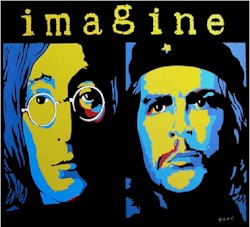Monday, July 13, 2009
A visit with Israel's victims
Michael Prysner, activist with the ANSWER Coalition and March Forward (a veterans antiwar group), is part of the Viva Palestina group hoping to shortly enter Gaza with humanitarian aid. While waiting in Egypt, he met with hospitalized victims of Israel's assault on Gaza. Some long excerpts from this powerful article, but please read the whole thing:
The first victim I met was Abdel Halim Jaber, 31, from the Jabalia refugee camp. Jabalia dates back to when the Zionists project was first established. Abdel’s parents were expelled from their homes and forced into this camp in 1948.
We told Abdel that we were from the United States, coming to bring over 50 cars and trucks filled with medical aid to break the siege of Gaza. He immediately broke down and started crying. We could only cry with him.
Abdel wiped tears from around the tube protruding from his nose with one hand, and with the other cradled the equipment coming out of his arms and his stomach. And he told his story.
He was walking with eight other family members to his sister’s house. There was no fighting in the area. There were no government or military buildings around; it was just ordinary city street.
A missile hit nearby. Shrapnel entered through his groin, destroyed his genitalia, his bladder, his colon, and his rectum, leaving pieces of metal throughout his body. He cannot eat anything, and can only take intravenous fluids. He relies on a catheter, artificial bladder, and a colostomy bag to function.
Abdel is still confined to a chair in the hospital. So far, he’s had six surgeries to try to rebuild him—or at least six that he remembers. The first few days were so traumatic, he has blanked them out.
He described the first week in the hospital in Gaza. The entire time, bombs were still being dropped. The hospital building was shaking nonstop, and he was sure he would be killed.
Abdel could not contain his tears talking about the trauma of thinking he was going to die every second—knowing that others were dying with every explosion, and that another explosion would surely follow somewhere.
I asked him what he wanted the people of the United States to know about the siege. "You have to expose what this has done to the children," he said. "They have suffered the most because of this."
He talked about his two sons. One of them was not physically uninjured in the attacks, but he had always received high grades in school. Since the massacre, he can’t function in the classroom and hasn’t passed a single test. "It has destroyed him," he said.
His other son, only 12 years old, developed malaria in his eyes because the blockade does not allow the necessary medication to cross into Gaza. Now he desperately needs eye surgery, but the necessary medical equipment can’t cross into Gaza either. He wept into his hand, telling us that soon his son would lose his sight permanently. Over and over, the Israeli government has denied his son permission to leave Gaza for treatment.
...
We have all seen the images of the attack on Gaza: the demolished buildings, the Israeli tanks, the explosions, the smoke rising from mounds of rubble. Those of us with the stomach for it have seen the images of the human toll, too. Parents lifting their dead children from the ash, people buried under concrete, screaming women with severed limbs.
But actually seeing the victims—sitting next to them, putting your hand on their shoulder, watching them shake and choke as they tell their stories, telling them that you’re sorry for what has happened—is the most indescribable, painful and paralyzing way to witness the suffering that Israel has unleashed on innocent human beings. I challenge any skeptic to see what I have seen today and not conclude that the Israeli and U.S. governments are guilty of war crimes and crimes against humanity.
To all of the victims I met today, I could only offer them one thing: that I would tell their stories. That their testimonies, their wounds, and their tears would help build the movement for justice in the United States.
They wished us luck on our trek to Gaza. We leave tomorrow for Al-Arish, then to Gaza on Sunday, to meet countless more like those whom I have met today, to hear countless more tragic stories and to see countless more destroyed lives. Today was only a few among many thousands.
I only hope that people in the United States begin to hear these stories and understand that we are bound by conscience and humanity to fight for what is right: ending this criminal siege and punishing those responsible.



